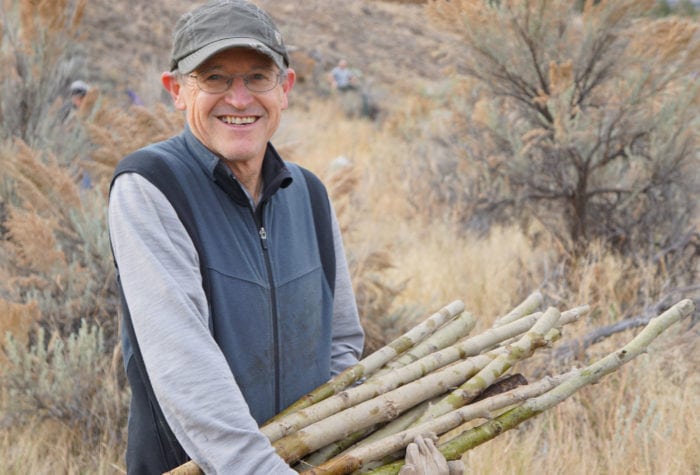Author: Lace Thornberg | Published: October 6, 2022 | Category: How-To
ONDA’s conservation work occurs on the traditional and ceded lands of the Northern Paiute, Wasco, Warm Springs, Bannock, Shoshone, Cayuse, Umatilla, Walla Walla, Klamath, Modoc, and Yahooskin peoples, and on lands currently managed by the Burns Paiute Tribe and the Confederated Tribes of Warm Springs.
As we approach Indigenous Peoples’ Day on October 10, 2022, ONDA encourages you to learn more about the rich history and present-day experiences of Indigenous peoples.
Here are three ways, specific to Oregon’s high desert, to mark this day.
Learn more about the Indigenous peoples of Oregon’s high desert.
Many Indigenous peoples live, use and enjoy, and practice cultural traditions in Oregon’s high desert today. Following are the Tribes and Indigenous communities that trace their history to Oregon’s high desert:
- Burns Paiute Tribe
- Confederated Tribes of Warm Springs
- Confederated Tribes of Umatilla Indian Reservation
- Klamath Tribes
- Fort McDermitt Paiute and Shoshone Tribes
Whatever you may know already about the Indigenous peoples of Oregon’s high desert, there is more to learn.
Select resources to enhance your knowledge of this region’s rich Indigenous presence:
- Legends of the Northern Paiute shares and preserves twenty-one original and previously unpublished Northern Paiute legends, as told by Wilson Wewa, a spiritual leader and oral historian of the Warm Springs Paiute.
- Northern Paiutes of the Malheur recounts the Paiutes’ true and proud history. As Nancy Egan, direct descendant of Chief Egan, notes, this book “captures the untold story of Chief Egan and our people, fulfilling the wish of my grandfather Hubert Egan for the true story of the Paiutes, hidden for almost a century and a half, to be revealed at last.”
- Native Land outlines an approximation of the Indigenous territories in North America.
Learn about Indigenous traditional ecological knowledge.
Indigenous Traditional Ecological Knowledge – ITEK – refers to the holistic, integrated knowledge of place, species, habitats, systems, and natural processes developed by indigenous people who have lived upon and stewarded the earth since time immemorial. While ITEK and western science represent two different ways of knowing, western ecological sciences and ITEK are often complementary because they both seek to understand the holistic relationships between living and nonliving elements of an ecosystem.
More information on ITEK:
- Native Knowledge: What Ecologists Are Learning from Indigenous People.
- Traditional Ecological Knowledge Lab at Oregon State University.
- Braiding Sweetgrass by Robin Wall Kimmerer.
- Summary of Ecological Restoration from the Society for Ecological Restoration.
Visit a museum or cultural center that shares Indigenous history.
An in-person visit to a Tribally-run cultural center will always provide a rich experience, but you can also learn a lot by visiting a museum’s website or by subscribing to their newsletters to learn more on an ongoing basis.
Tribally-run cultural centers in eastern Oregon:
- The Museum at Warm Springs (Warm Springs, Oregon) was the first Tribally owned museum in the West.
- Tamástslikt Cultural Institute (Pendelton, Oregon) celebrates the traditions of Cayuse, Umatilla, and Walla Walla Tribes.
Other museums that include the perspectives, history, and art of Indigenous peoples of Oregon’s high desert:
- The Oregon—Where Past is Present exhibit at the Museum of Natural and Cultural History at the University of Oregon combines interactive displays with world-class anthropological collections to share 14,000 years of Oregon stories. Free admission on Indigeous Peoples’ Day.
- You can search the Art & Cultures database managed by the Burke Museum by “Culture of Origin”, selecting Paiute, Wasco, and other cultures.
- The Infinity of Nations exhibit hosted by National Museum of the American Indian highlights artifacts from the Great Basin, such as this Northern Paiute winnowing basket.
We hope to have given you a starting point, and, of course, these are only a few of the numerous opportunities to experience the cultures and perspectives of Indigenous peoples. This Indigenous Peoples’ Day can be just one of many days where you make a point to attend local celebrations where appropriate, tune into virtual events and workshops, watch films by Indigenous directors, listen to podcasts with Indigenous hosts, and learn more about Indigenous cultures.
